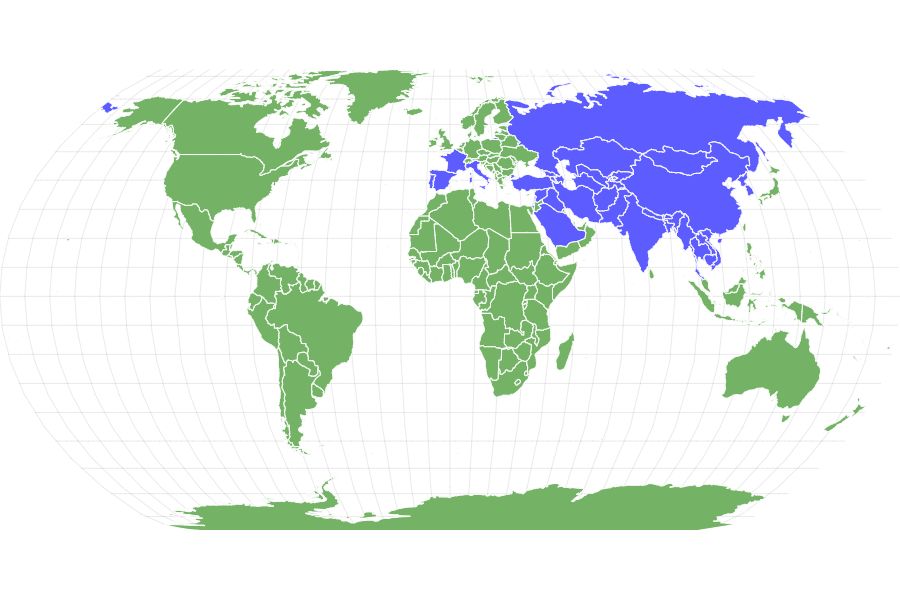Cinereous Vulture
Aegypius monachus
This vulture can fly at great heights. At least one was found a few thousand feet from the top of Mount Everest.
Advertisement
Cinereous Vulture Scientific Classification
- Kingdom
- Animalia
- Phylum
- Chordata
- Class
- Aves
- Order
- Accipitriformes
- Family
- Accipitridae
- Genus
- Aegypius
- Scientific Name
- Aegypius monachus
Read our Complete Guide to Classification of Animals.
Cinereous Vulture Conservation Status
Cinereous Vulture Facts
- Prey
- Calves, kids, lambs, piglets, young birds, rodents, reptiles and amphibians
- Fun Fact
- This vulture can fly at great heights. At least one was found a few thousand feet from the top of Mount Everest.
- Biggest Threat
- Poisoning, poaching
- Most Distinctive Feature
- Their great size
- Other Name(s)
- Eurasian black vulture, monk vulture, black vulture
- Wingspan
- 8 to 9.5 feet
- Incubation Period
- 53 days
- Litter Size
- 1
- Habitat
- Forests, mountains, semi-deserts, often at heights between 330 and 6562 feet.
- Predators
- Humans
- Diet
- Carnivore
- Type
- Bird
- Common Name
- Cinereous vulture
- Number Of Species
- 1
- Location
- Eurasia, Asia, Middle East, Africa
- Average Clutch Size
- 2
- Nesting Location
- Trees and ledges
- Age of Molting
- 95 to 120 days
View all of the Cinereous Vulture images!
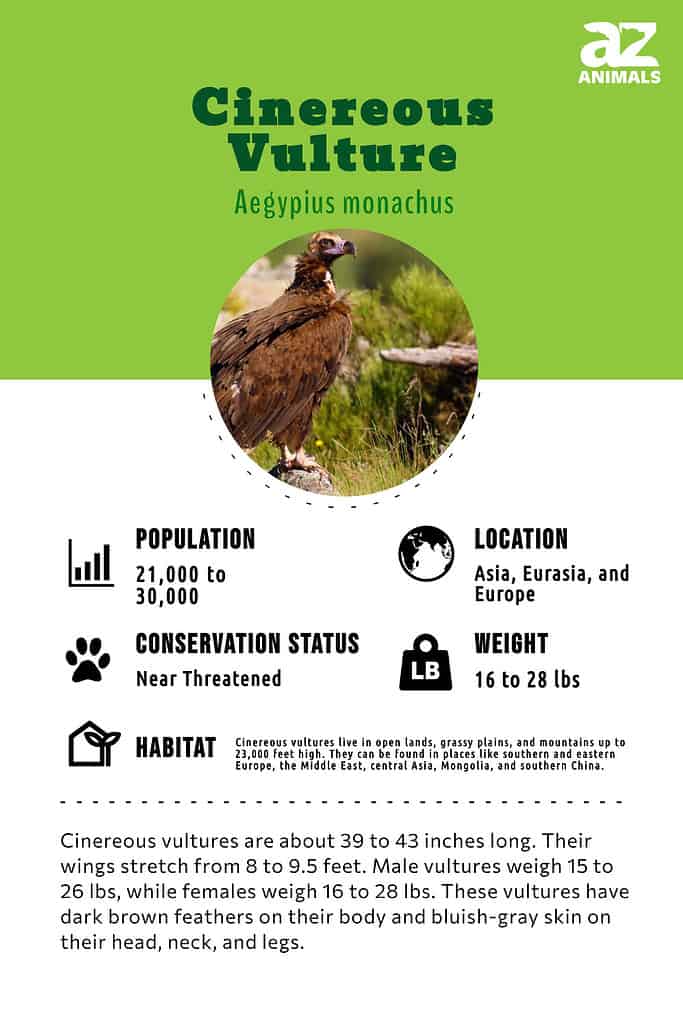
“Can the Cinereous Vulture be the largest vulture on earth?”
You really need to be in its presence to appreciate how big this Old World bird of prey is! Its body can be nearly 4 feet long, and it can have a 9.5-foot wingspan. Some people think it’s indeed the biggest bird of prey on earth, even bigger than a condor. That’s controversial, but there’s no doubt that this Eurasian vulture is one of the biggest flying birds in the world.
4 Cinereous Vulture Amazing Facts
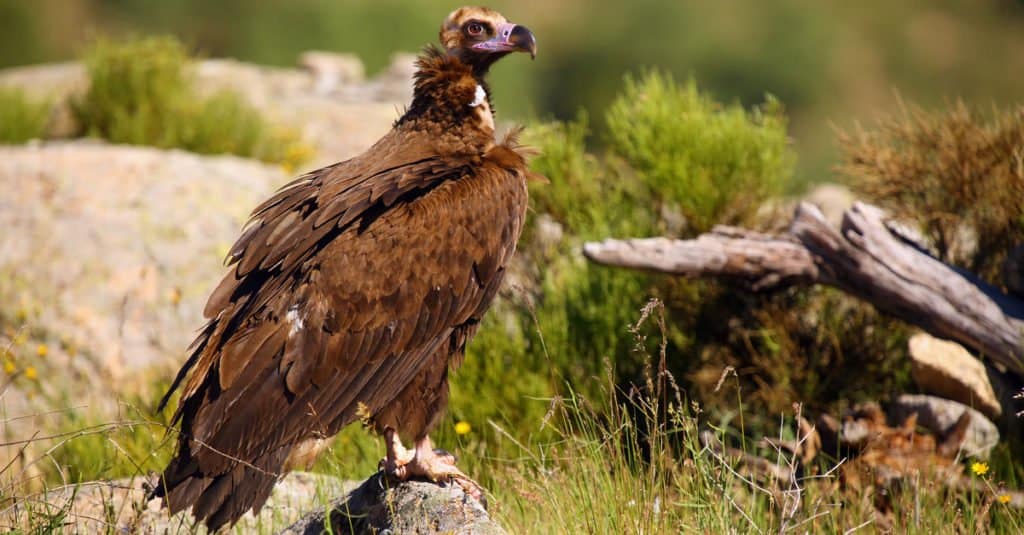
The Cinereous Vulture is one of the most affectionate parents.
©Karel Bartik/Shutterstock.com
- It has an adaptation in its blood that lets it take in more oxygen when it’s flying at great heights.
- The vulture scavenges on humans who have a sky burial. This is accepted by practitioners who believe there’s no need to preserve a dead body.
- Like the lappet-faced vulture of Africa, the cinereous vulture’s bill is powerful enough to tear open the toughest hides.
- The vulture doesn’t often kill its food, but it has been known to pick up a tortoise and drop it from a great height. This shatters the shell and makes it easier for the bird to access the soft parts.
Evolution and Origins
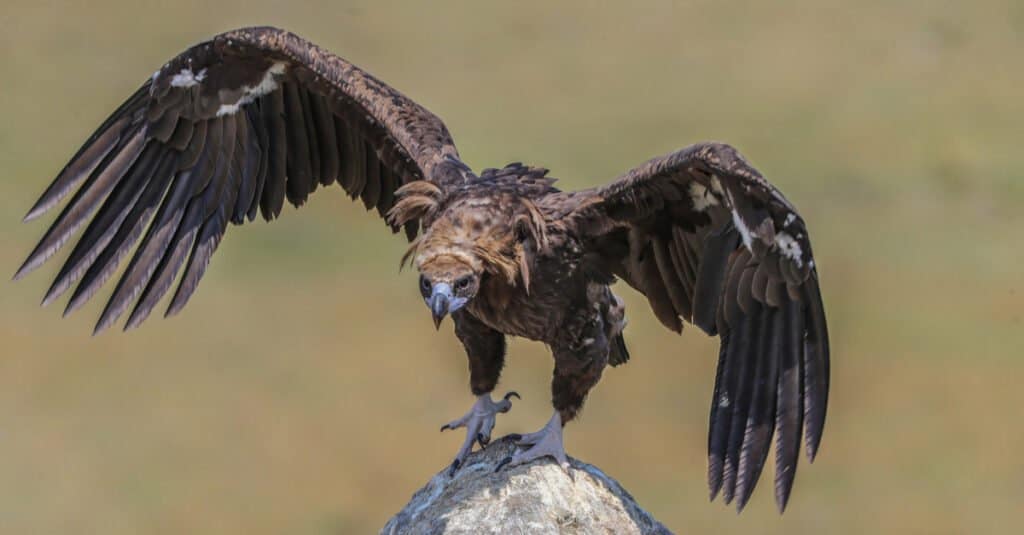
Cinereous Vultures have robust hooked beaks that are specialized for ripping apart flesh.
©yabaninizinde/Shutterstock.com
In the past, vultures were once thought to have evolved only once among extant diurnal birds of prey. Now, New World Vultures are classified as ancestrally related, or near to the storks. Meanwhile, Old World Vultures are more definitively linked to raptors or bird of prey ancestors.
Cinereous Vultures have robust hooked beaks that are specialized for ripping apart portions of flesh from carcasses. They possess a third eyelid that shields their eyes from blood and tissue. While a diet of deceased creatures might seem unpalatable, vultures effectively engage in recycling by using carrion as sustenance.
Old World Vultures are related to hawks and eagles in a group. Some experts say New World vultures are in their own group. This separation – vultures versus hawks – occurred over 50 million years ago, as shown by DNA proof.
Where To Find Them
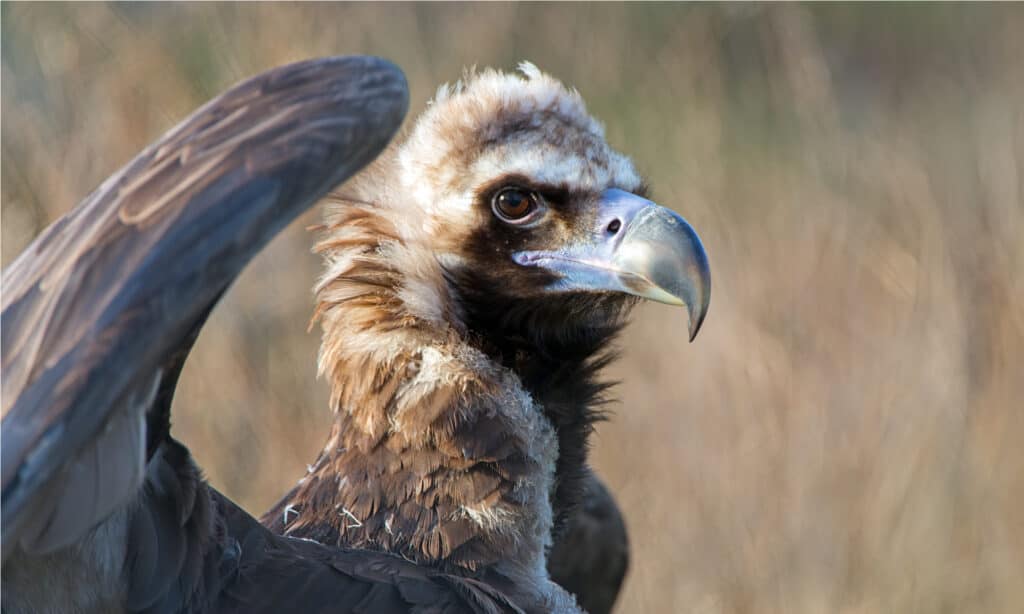
The enormous Cinereous Vulture can grow to between 43 and 47.24 inches in length, weigh up to 31 pounds, and have a nearly 10-foot wingspan.
©davemhuntphotography/Shutterstock.com
The cinereous vulture is found in countries in Eurasia such as Tajikistan and Kyrgyzstan. Other places where the vulture is found include mainland China, Afghanistan and Pakistan, Iran, India, and the Koreas. It’s also found in European countries such as Spain, Greece, and Bulgaria. They prefer habitats that are mountainous, open, or semi-open where it is easy to spot carcasses from the air.
Cinereous Vulture Nests
As the vulture is a big bird, it builds a big nest, usually in an older tree or the edge of a cliff. Both parents help build the nest, which can be nearly 7 feet across and nearly 10 feet deep. Because a monogamous pair uses the same nest year after year, the size of the nest can grow. It is made out of sticks, twigs, branches, and sometimes trash and over the years can be embellished, if that’s the word, with the hides of animals and dung. Unlike a lot of birds, cinereous vultures don’t appear to clean the nest while they’re raising their chick.
Scientific Name
The vulture’s scientific name is Aegypius monachus. Aegypius simply means “vulture or vulture-like bird” in Greek. Monachus is ancient Greek for “single” or “solitary” and gives the vulture its other name of “monk vulture.” Cinereous comes from the Latin for “ash-colored,” which is cineraceus.
This differentiates Aegypius monachus, which is sometimes called the black vulture, from the much smaller North American black vulture, Coragyps atratus. There are only one species of cinereous vulture.
Appearance
This enormous bird can grow to between 43 and 47.24 inches in length, weigh up to 31 pounds, and have a nearly 10-foot wingspan. Its feathers are black or brown, its eyes are large and brown, and its powerful hooked beak is black. Unlike many other vultures, its head is feathered but the feathers are small.
The bird’s legs are gray or cream-colored when it is an adult and pink when it’s a juvenile, as is its beak. Females are a bit bigger and heavier than males, which is often the case with accipitrids.
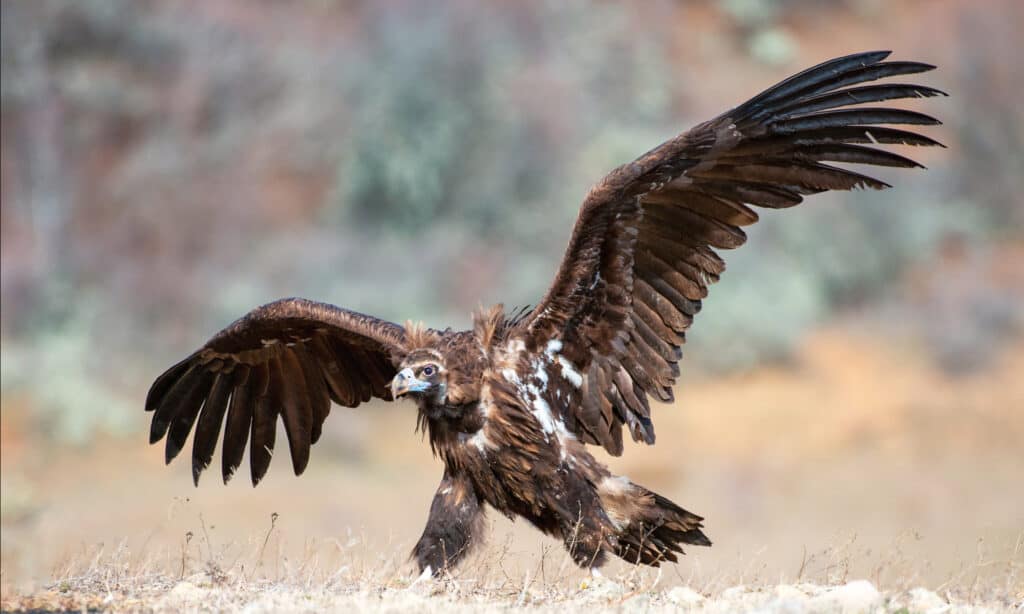
Cinereous vulture (Aegypius monachus)
females are a bit bigger and heavier than males.
©WildlifeWorld/Shutterstock.com
Cinereous Vulture vs. Harpy Eagle
Both the cinereous vulture and the harpy eagle are impressively large and somewhat scary-looking birds, but there are important differences between them.
The harpy eagle, for one thing, is an eagle who routinely hunts, kills, and eats its prey. The cinereous vulture is mostly a scavenger. The harpy eagle also lives on the other side of the world from the cinereous vulture. It is found in Mexico and Central and South America. Unlike the open steppes and mountains favored by the vulture, the harpy eagle largely lives in the rainforest habitat.
Though it’s considered a huge bird, the harpy eagle is smaller than the cinereous vulture. Its length ranges from 34 to 42 inches in length, it can weigh up to 22 pounds or more, and it can have a wingspan of 5.77 to 7.34 feet.
The harpy eagle is like the cinereous vulture in that females are bigger and heavier than males. In contrast to the vulture’s plain brown or black plumage, the harpy eagle has feathers that are patterned in black, white, and gray. It also has a double crest on its head and fantastically large and strong talons that allow it to pick up prey that weighs the same as itself.
The breeding behavior of the harpy eagle and the cinereous vulture are similar in that both are monogamous, and they raise only one chick at a time. In the case of the vulture, it’s because the female only lays one egg. In the case of the eagle, the female lays two eggs, but when the first egg hatches the second one is ignored and allowed to languish.
Behavior
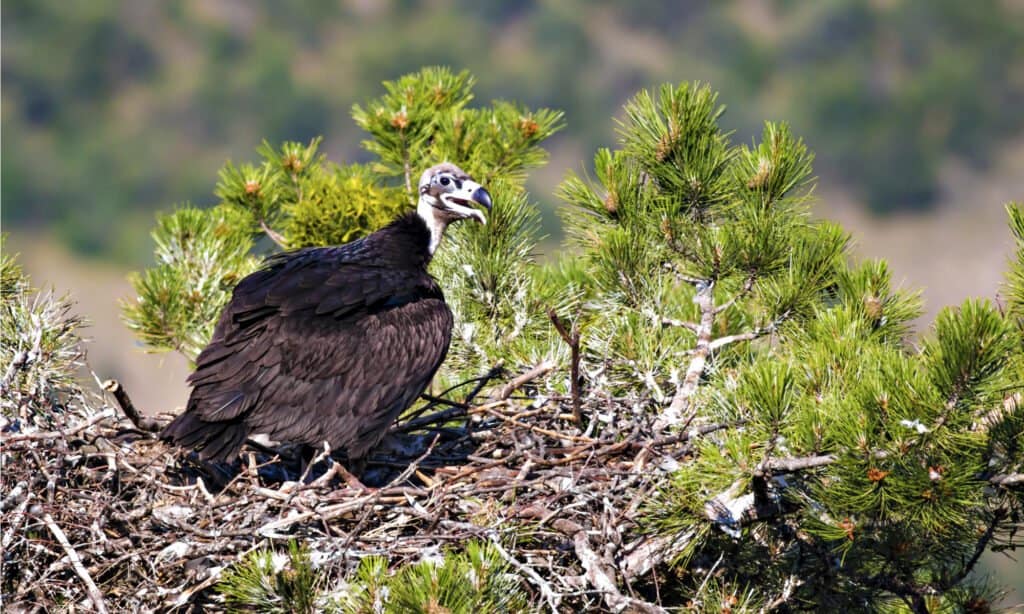
The Cinereous vulture builds a big nest, usually in an older tree or the edge of a cliff.
©serkan mutan/Shutterstock.com
Cinereous vultures are solitary, which along with the tonsure-like ruff of feathers around their neck, gives them the name “monk vulture.”
They do not even congregate in great numbers at a food site, and there are rarely more than a dozen or so birds at what ornithologists call a “wake.” While feeding, they dominate all the other scavengers who want to get a piece of the carcass, including foxes, and their behavior can be a bit thuggish towards them.
They don’t migrate, but they will fly for miles to find food, then return to their usual roosts at night. They are usually silent, like most vultures, but vocalize in mewls, grunts, and roars during the mating season.
Cinereous Vulture Migration Pattern and Timing
These Eurasian vultures don’t migrate but have been known to fly as much as 46.6 miles from their roosts in search of food.
Diet
The vulture is mostly a scavenger that eats a variety of carcasses, including those of yaks, wild boars, chickens, deer, cattle, gazelles, marmots, rabbits, foxes, and humans. Once in a while, it will take live prey, and this includes the usually sickly young of cattle, yaks, sheep, pigs, and dogs. It sometimes eats lizards and insects and raids the nests of waterfowl such as swans or geese and is believed to hunt certain species of antelope such as the saiga.
Predators and Threats
The only real predator for a bird this large and powerful is a human. Humans inadvertently kill the vulture by poisoning carcasses. The poison is meant for animals considered to be vermin such as jackals and foxes. The vulture is also hunted for sport. Overall, its numbers are declining and its conservation status is near threatened.
Reproduction, Babies, and Lifespan
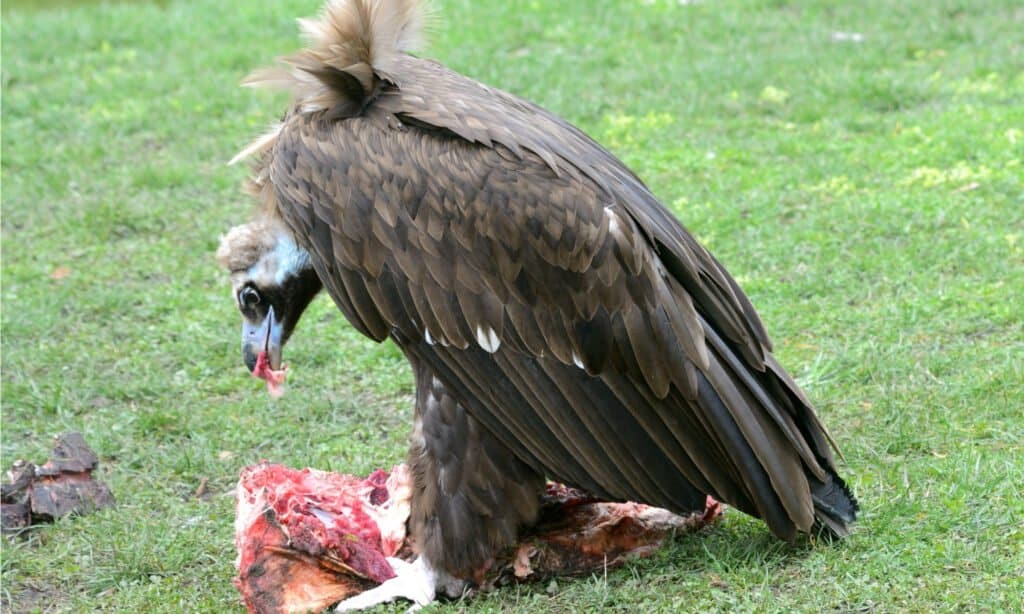
Like the lappet-faced vulture of
Africa
, the cinereous vulture’s bill is powerful enough to tear open the toughest hides.
©Alexandr Junek Imaging/Shutterstock.com
Cinereous vultures are monogamous and mate for life. There’s only one breeding season per year, and it occurs in October and November. The female usually lays only one egg, and two eggs are unusual. Both parents build the nest, incubate the egg and feed the chick.
The egg takes between 50 and 55 days to hatch, and the chick is covered with grayish down that eventually turns white before the feathers come in. Parents still take care of it for as long as seven and a half months, which is about two months after it has fledged. The chick will be ready to breed when it’s between four and five years old and can have a lifespan of as long as 40 years.
Population
The population of the cinereous vulture is between 16,800 and 22,800 individuals and is decreasing. The conservation status is near threatened.
View all 235 animals that start with CCinereous Vulture FAQs (Frequently Asked Questions)
Does the Cinereous Vulture Migrate?
The vulture doesn’t migrate but can fly great distances in search of food.
How many eggs does the Cinereous Vulture lay?
This vulture lays one egg at a time. Rarely, it may lay two.
How fast does the Cinereous Vulture fly?
Scientists haven’t really clocked the cinereous vulture, but it is a slow flier. It mostly glides on the wind and doesn’t need to flap its wings very often.
What is the Cinereous Vulture’s Wingspan?
Its wingspan is between 8 and 9.5 feet.
When does the Cinereous Vulture leave the nest?
The chick leaves the nest when it’s between 95 and 120 days old, but its parents continue to care for it for some time afterward.
How long do cinereous vultures live?
They can live a long time for a bird. Their lifespan ranges between 28 and 40 years.
How high can a cinereous vulture fly?
The heights this vulture can achieve are impressive. At least one was found at 22,870 feet around Mount Everest.
Is the cinereous vulture the largest vulture in the world?
Whether the cinereous vulture is the largest vulture in the world is uncertain, and many people believe that the Andean condor still has an edge. But it remains an eye-popping large bird.
Thank you for reading! Have some feedback for us? Contact the AZ Animals editorial team.
Sources
- Datazone, Available here: http://datazone.birdlife.org/species/factsheet/cinereous-vulture-aegypius-monachus
- Wikipedia, Available here: https://en.wikipedia.org/wiki/Cinereous_vulture
- ITIS, Available here: https://www.itis.gov/servlet/SingleRpt/SingleRpt?search_topic=TSN&search_value=175494#null
- Wikipedia, Available here: https://en.wikipedia.org/wiki/Harpy_eagle
- Kidadl, Available here: https://kidadl.com/animal-facts/cinereous-vulture-facts

